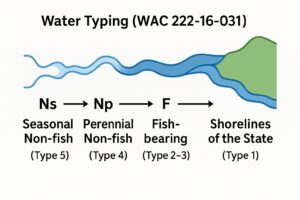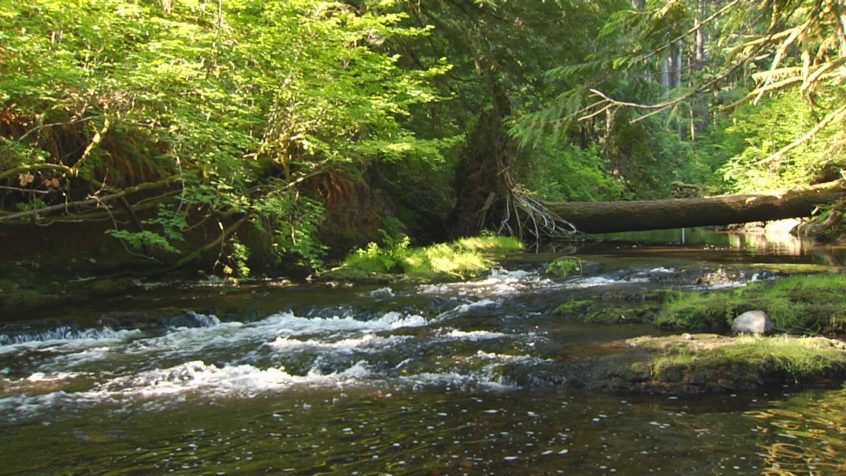On June 6, 2025, the Washington Forest Practices Board (FPB) took a consequential vote that will reshape how water is classified and protected under the state’s Forest Practices Rules. The Board adopted a new Water Typing System rule and an associated Board Manual section (BM 23), marking the culmination of years of debate, modeling, and negotiation over how best to define and map fish streams in Washington’s managed forests. These decisions are a direct outgrowth of the state’s landmark Forests & Fish Law, and while they reflect progress in some areas, they also raise questions about implementation and future impacts on working forests.
Background: A Product of the Forests & Fish Agreement
The Forests & Fish Law was passed in 1999 as a collaborative solution to decades of conflict over logging, water quality, and salmon recovery. It brought together large and small forest landowners, the state, tribes, federal agencies, and environmental groups under a single vision: to ensure regulatory certainty while improving water quality and fish habitat protections. One of the core components of the agreement was a commitment to adaptive management—allowing science and stakeholder collaboration to drive rule changes when needed.
 Water typing—the classification of streams based on fish habitat or non-fish habitat is foundational to how riparian buffer protections are applied. Fish habitat streams receive larger riparian buffers than non-fish habitat streams. For years, concerns about outdated maps and inconsistent survey methods led to efforts to modernize the system. The lengthy review process culminated in a new approach that uses permanent, physical stream features as potential habitat breaks (PHBs) and the presence or absence of fish to determine the demarcation between fish habitat and non-fish habitat streams. The new approach also incorporates the concept of an anadromous fish floor (AFF) downstream of which anadromous fish use is presumed and therefore no need to make fish habitat and non-fish habitat determinations.
Water typing—the classification of streams based on fish habitat or non-fish habitat is foundational to how riparian buffer protections are applied. Fish habitat streams receive larger riparian buffers than non-fish habitat streams. For years, concerns about outdated maps and inconsistent survey methods led to efforts to modernize the system. The lengthy review process culminated in a new approach that uses permanent, physical stream features as potential habitat breaks (PHBs) and the presence or absence of fish to determine the demarcation between fish habitat and non-fish habitat streams. The new approach also incorporates the concept of an anadromous fish floor (AFF) downstream of which anadromous fish use is presumed and therefore no need to make fish habitat and non-fish habitat determinations.
The June 6 Vote: A Qualified Milestone
At its June 6 special meeting, the Forest Practices Board voted 10 to 1 to adopt the revised Water Typing System rule. Only one member—from the conservation caucus—voted against the change. The newly adopted rule introduces the phrase “biologically significant” into the regulatory language, describing the kind of measurable features that indicate the upstream extent of the AFF. While this phrase was a late addition and drew opposition from counties, private forest landowners, and the Washington Forest Protection Association (WFPA), it was ultimately accepted in the spirit of cooperation.
In parallel, the Board adopted Board Manual Section 23, which outlines the procedures for applying the new system in the field. Landowners expressed guarded support for BM 23 while raising concerns about how some provisions might play out in practice. Importantly, they flagged the need for ongoing stakeholder engagement to address unresolved questions and ensure consistent implementation.
What Changes, and When?
The new Water Typing System rule is set to take effect on January 1, 2026. Until then, forest landowners and state agencies will continue using the current rules and procedures, including submitting Water Type Modification Forms (WTMFs) under the existing system.
One sticking point in the June 6 discussion was how to handle the transition. Landowners asked for an extension on the ability to submit WTMFs under the current rules, citing concerns about processing capacity and the desire to meter the workload more smoothly during the switch. However, Department of Natural Resources (DNR) staff declined to grant a blanket extension during the meeting, though they left the door open to further dialogue between individual landowners and DNR field staff.
In terms of support, training sessions and updated materials will be rolled out over the next six months to help landowners, tribes, other agencies, and DNR staff adjust to the new requirements.
Trust and Implementation: The Road Ahead
One of the enduring principles of the Forests & Fish Law is that rule changes must be grounded in science and accompanied by appropriate guidance, training, and review. During the June 6 meeting, DNR offered only a vague commitment to additional stakeholder work in the short term, though they made a more definitive promise to evaluate implementation over time and make necessary revisions to the Board Manual.
This two-step approach—implement now, adjust later—has been a point of friction in past rulemakings. It reinforces the need for a functioning Adaptive Management Program (AMP) that ensures agency accountability and responsiveness to new data and field experience. For private landowners, who are often asked to bear the cost of regulatory changes, predictable and transparent implementation is not just a preference, it’s a necessity.
Looking Ahead
The June 6 vote represents both closure and beginning. It closes a long chapter of scientific study and policy development around stream typing, but it also opens a new phase in how these changes will be carried out on the ground. Whether the rule succeeds in improved consistency in determining fish habitat streams from non-fish habitat streams without creating undue burdens will depend on the quality of implementation, the responsiveness of state agencies, and the ongoing involvement of all parties to the Forests & Fish Agreement.
For now, forest landowners are moving forward—cautiously—but with a clear message: science-based decisions, regulatory transparency, and fair process must continue to guide how Washington balances environmental protection with a working forest landscape. To that end, forest landowners are supporting AMP validation studies of the new system–currently underway in the field to ensure it meets public resource protection objectives.
